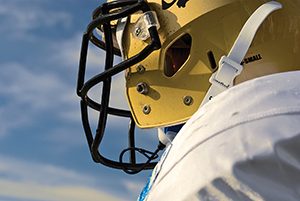
 The Christian high school had much to be proud of: a history of academic excellence; a great reputation for community service; and also, as a much respected perennial contender for state football champion.
The Christian high school had much to be proud of: a history of academic excellence; a great reputation for community service; and also, as a much respected perennial contender for state football champion.
By Michael J. Bemi
Critically, the school’s head injury prevention and care program was in many regards enviable and a model to be emulated. For example, this high school invested in only the finest athletic equipment and ensured that all equipment was certified to meet the safety standards promulgated by the National Organization for Care and Safety of Athletic Equipment (NOCSAE).
Further, an excellent Concussion Management Protocol (CMP) was in place and enforced. The school employed a certified athletic trainer and engaged a board-certified sports medicine specialist as school physician. All coaches, physical education teachers, the certified athletic trainer and the school nurse were trained on concussion management and care, and each repeated this training every two years. Prior to the beginning of each season, every student athlete participating in contact sports had to be evaluated via a baseline Standardized Concussion Assessment Tool (SCAT) or Impact Assessment Tool. Parents were given materials to educate them on the issue of head injuries / concussion and were required to sign a document each season acknowledging the inherent risks of contact sports and authorizing their child to participate.
The certified athletic trainer was required to be present for all training, practice and actual events, and arrangements were made for an emergency care vehicle / team to be present at all games, even though state law did not require this.
Finally, when an injury did occur, the school employed the Zurich Progressive Exertion Protocol as a minimum return to activity plan, plus insisted that the student’s personal physician approve in writing the return to activity.
The high school’s star (and All State) wide receiver experienced a concussion following a hit early in the season. Employing the CMP, he was immediately assessed by the certified athletic trainer and coaching staff and pulled from the game. He was restricted from training, practice or play until his personal physician released him to resume activity.
Ten days later, he returned to practice. The following weekend, he started the game and played well. In the third quarter, he was blind-sided in a vicious hit. He walked to the sideline and immediately collapsed. He then experienced a rare, frequently fatal (and medically controversial) phenomenon referred to as Second Impact Syndrome (SIS), in which the brain cannot control its blood volume, leading to cerebral hemorrhaging and possible herniation — with devastating results.
He received immediate emergency care, due to the presence of the pre-arranged emergency vehicle / team, but he nevertheless suffered massive brain trauma with resultant life-long, very major physical and cognitive deficiencies.
Could anything else have been done?
 Yes, according to the post-incident investigation and analysis, several additional preventive measures could have been taken.
Yes, according to the post-incident investigation and analysis, several additional preventive measures could have been taken.
For example, interviews with fellow players indicated that several had noticed during practice that week that the young star seemed at times disoriented and confused. They simply attributed this to him being “rusty” after missing a week’s practice and a Friday night game. The school should have required all athletes participating in contact sports to be educated on the signs / symptoms of concussion.
Also, the school’s CMP suggested — but didn’t require — performance of a new SCAT assessment before return to practice and play. The suggestion in the protocol should have been a requirement.
Finally, the school failed to wait for their physician specialist’s assessment of the personal physician’s release report, with which the specialist, in fact, took issue. The school medical specialist should be the source of final approval for return to training, practice and play.
Most schools value the benefits of physical activity and athletic participation. They need to remember that when it comes to head injury prevention — whether on the field or the playground — you can never do too much.
Michael J. Bemi is president & CEO of The National Catholic Risk Retention Group, Inc. (Lisle, IL) — a recognized leader in risk management. To learn more about available coverage — and to get valuable tools, facts and statistics — visit www.tncrrg.org.


